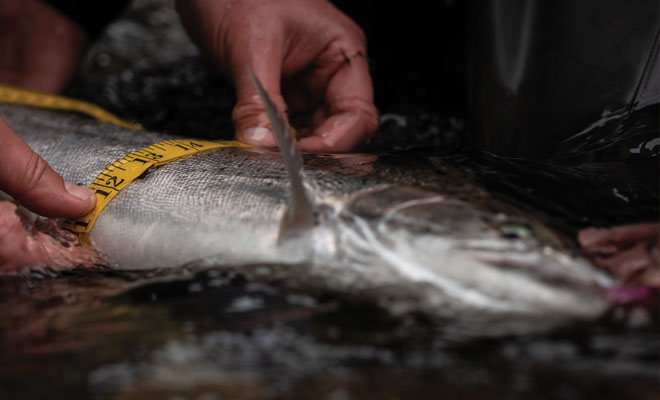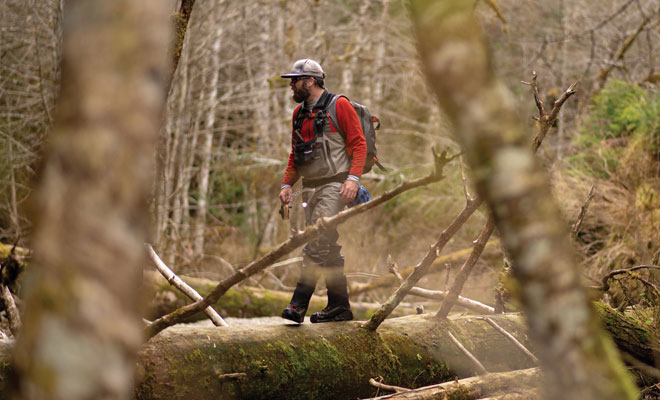
Taking measurements of a wild steelhead caught on a previously undocumented steelhead stream in the Tongass National Forest.
Anadromous Waters Catalog
Blog by Jenny Weis
Photos by Josh Duplechian
Anadromous Waters Catalog: The Catalog of Waters Important for the Spawning, Rearing or Migration of Anadromous Fishes
Alaskan steelhead anglers must be crazy. No one else would walk for miles along a stream, slogging through rotten snow, fighting acres of devil’s club and underbrush, getting gear stuck in impossible snags, all for a fish they may never find and are going to release anyway.
For many anglers, southeast Alaska and the sprawling Tongass National Forest have long been known as the place to be to greet the spring runs of steelhead as they return to their birth streams to spawn. Every April, from Yakutat to Ketchikan, anglers converge on a handful of steelhead streams, some well known and many more secret, in hopes of hooking into one of these chrome bullets.
But asking a steelhead angler which stream he or she visited may not result in the information you seek. Steelheaders are a notoriously secretive subset of the angling world.
“Obfuscation, misdirection, and outright lying, even to fishing partners, is all part of the steelheaders’ ethos,” said Mark Hieronymus, Alaska Sportfish Outreach Coordinator for Trout Unlimited. “I believe this is partly based on the legwork involved in being a successful steelhead angler, and in this case, I mean “legwork” quite literally.”
In southeast Alaska’s smaller, coastal stream systems, about three quarters of the known steelhead runs are made up of 200 spawning adults per year or fewer. This means in many places an angler can walk for miles between opportunities to wet a line.
Southeast Alaska is home to around 320 known steelhead streams. But Hieronymus believes the true number is probably twice that.
“If you knew of a good river to fish and you rarely, if ever, saw other anglers there, you’d probably want to keep it to yourself, too,” he said.
“But therein lies the rub—if steelhead aren’t listed in the Anadromous Waters Catalog for that particular river, their habitat isn’t afforded the conservation measures they deserve.”

Mark Hieronymus evaluating the creek and obstacles ahead on the hunt to document wild steelhead in new areas within the Tongass National Forest.
The Catalog of Waters Important for the Spawning, Rearing or Migration of Anadromous Fishes, better known as the Anadromous Waters Catalog, is the Alaska Department of Fish and Game’s list of all streams, rivers or lakes in Alaska it deems important for salmon and other anadromous fishes—meaning fish that are born in freshwater, spend most of their lives in saltwater, and return to freshwater as adults to spawn. In southeast Alaska, the catalog identifies approximately 8,000 waters.
Once included in the catalog, anyone looking to develop in that waterway must adhere to conservation measures, such as timing activities to avoid spawning and migration, so fish resources aren’t harmed in the construction process.
However, ADF&G also estimates that less than half of the anadromous waters in southeast Alaska are currently listed in the Anadromous Waters Catalog. In addition to not listing every water body with anadromous fish, the catalog is often incomplete or inaccurate in identifying how far upstream anadromous fish migrate or which species are present. For fish like steelhead, which spend much longer than most salmon rearing in freshwater and spawn in the spring well before most other salmon begin their migration from the ocean, any inaccuracies in the catalog means the habitat on which steelhead rely isn’t adequately protected under State of Alaska law.
“We decided it was time to change that,” said Hieronymus.
In the spring of 2018, Hieronymus took an inaugural group of Trout Unlimited staff and members to survey three streams in three separate watersheds contained within the “Tongass 77,” a collection of waters scientists and stakeholders around Southeast determined to be the best fish producers within the forest. Selecting the locations mostly based on anecdotal evidence, the team sought to document presence or absence of steelhead in those waters in the official manner required by the state.
Their instincts were right. The group successfully documented adult steelhead in two of the three streams surveyed. After rigorously documenting the steelhead and navigating the complex nomination process, as of June 1, 2019, both streams are now officially recognized in the Anadromous Waters Catalog as steelhead producers and gain additional protections under state law.
“I don’t want to rely on a system that may or may not let a run, or a river’s worth of fish, wink out of existence because the state doesn’t have the time or money to get them accounted for,” said Hieronymus.
Inclusion in the catalog doesn’t put the stream off limits for development. It creates a system that makes sense for developers and for fish. In some cases, timing windows are used to limit when construction projects can occur so development can avoid sensitive times for fish, such as during migration or spawning. For steelhead, this is from roughly March through late July, as this is a time when adult steelhead are migrating in freshwater to spawn, and when their eggs are developing in the streambed.
Similarly, if development is proposed in an area where ADF&G knows anadromous fish are present, the state will survey the area repeatedly to determine if fish rely on the section of stream or river that is proposed for the project. If important areas are identified, they are avoided.
Last year, Trout Unlimited redoubled its efforts, visiting three Sitka-area “Tongass 77” watersheds in search of steelhead. In addition, 12 streams on north Chichagof Island were surveyed for the presence of juvenile anadromous fish, beyond just steelhead. As a result, Trout Unlimited submitted nominations for two new steelhead streams; to include coho, Dolly Varden, and cutthroat trout on streams where those species were not previously listed; and to expand the catalog to include nearly five-and-a-half miles of previously undocumented salmon habitat.
“The work has just begun,” said Hieronymus. “The long-term slog is now to continue. We started. Now what?”
All told, Trout Unlimited hopes to have four new species additions and nearly 10 miles of previously undocumented habitat added to the Anadromous Waters Catalog. Trout Unlimited plans to continue this work in 2020 and beyond, and invites the public to join in the effort to fill in data gaps and provide basic protections for the habitat on which the fish we all value rely.
You’ve just got to love steelhead—and tolerate cold water, devil’s club, and long walks—to find them.
Download the RIVERS app and help collect data! Download the RIVERS survey within the Survey123 app for ArcGIS from your respective app store. Full details here.
This blog originally appeared in the April 2020 issue of Fish Alaska.
